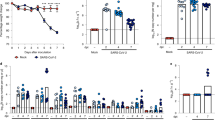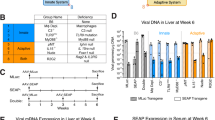Abstract
Gene therapy holds great potential for the treatment of various acquired and inherited pulmonary diseases. Among various viral vectors, adeno-associated viral (AAV) vectors have been most frequently used in different clinical trials of pulmonary gene therapy. In the present study, we examined the kinetics and duration of transgene expression, vector biodistribution and development of neutralizing antibodies (NAB) in mice after pulmonary application of AAV2/9 vector. The pulmonary route of application did not affect any of the measured parameters. Transgene expression and biodistribution analysis at day 450 post-application confirmed the systemic spread of the vector after pulmonary delivery. Using SPB−/− mice, the study shows that AAV2/9-mediated gene expression is influenced by animal gender but not mouse genotype and is insensitive to the presence of lung inflammation. Lower expression levels were observed in male compared with female mice, and transient immunosuppression with dexamethasone significantly reduced the development of NAB in both genders of mice. The study thus advances this serotype for further development and use as a therapeutic vector.
This is a preview of subscription content, access via your institution
Access options
Subscribe to this journal
Receive 12 print issues and online access
$259.00 per year
only $21.58 per issue
Buy this article
- Purchase on Springer Link
- Instant access to full article PDF
Prices may be subject to local taxes which are calculated during checkout






Similar content being viewed by others
References
Flotte TR, Ng P, Dylla DE, McCray Jr PB, Wang G, Kolls JK et al. Viral vector-mediated and cell-based therapies for treatment of cystic fibrosis. Mol Ther 2007; 15: 229–241.
Russell DW, Miller AD, Alexander IE . Adeno-associated virus vectors preferentially transduce cells in S phase. Proc Natl Acad Sci USA 1994; 91: 8915–8919.
Daya S, Berns KI . Gene therapy using adeno-associated virus vectors. Clin Microbiol Rev 2008; 21: 583–593.
Virella-Lowell I, Zusman B, Foust K, Loiler S, Conlon T, Song S et al. Enhancing rAAV vector expression in the lung. J Gene Med 2005; 7: 842–850.
Rabinowitz JE, Rolling F, Li C, Conrath H, Xiao W, Xiao X et al. Cross-packaging of a single adeno-associated virus (AAV) type 2 vector genome into multiple AAV serotypes enables transduction with broad specificity. J Virol 2002; 76: 791–801.
Halbert CL, Allen JM, Miller AD . Adeno-associated virus type 6 (AAV6) vectors mediate efficient transduction of airway epithelial cells in mouse lungs compared to that of AAV2 vectors. J Virol 2001; 75: 6615–6624.
Halbert CL, Miller AD, McNamara S, Emerson J, Gibson RL, Ramsey B et al. Prevalence of neutralizing antibodies against adeno-associated virus (AAV) types 2, 5, and 6 in cystic fibrosis and normal populations: implications for gene therapy using AAV vectors. Hum Gene Ther 2006; 17: 440–447.
Limberis MP, Wilson JM . Adeno-associated virus serotype 9 vectors transduce murine alveolar and nasal epithelia and can be readministered. Proc Natl Acad Sci USA 2006; 103: 12993–12998.
Halbert CL, Lam SL, Miller AD . High-efficiency promoter-dependent transduction by adeno-associated virus type 6 vectors in mouse lung. Hum Gene Ther 2007; 18: 344–354.
Halbert CL, Miller AD . AAV-mediated gene transfer to mouse lungs. Methods Mol Biol 2004; 246: 201–212.
Sumner-Jones SG, Davies LA, Varathalingam A, Gill DR, Hyde SC . Long-term persistence of gene expression from adeno-associated virus serotype 5 in the mouse airways. Gene Therapy 2006; 13: 1703–1713.
Liqun Wang R, McLaughlin T, Cossette T, Tang Q, Foust K, Campbell-Thompson M et al. Recombinant AAV serotype and capsid mutant comparison for pulmonary gene transfer of alpha-1-antitrypsin using invasive and noninvasive delivery. Mol Ther 2009; 17: 81–87.
Zabner J, Seiler M, Walters R, Kotin RM, Fulgeras W, Davidson BL et al. Adeno-associated virus type 5 (AAV5) but not AAV2 binds to the apical surfaces of airway epithelia and facilitates gene transfer. J Virol 2000; 74: 3852–3858.
Limberis MP, Vandenberghe LH, Zhang L, Pickles RJ, Wilson JM . Transduction efficiencies of novel AAV vectors in mouse airway epithelium in vivo and human ciliated airway epithelium in vitro. Mol Ther 2009; 17: 294–301.
Flotte TR, Laube BL . Gene therapy in cystic fibrosis. Chest 2001; 120: 124S–131S.
Gavin MA, Gilbert MJ, Riddell SR, Greenberg PD, Bevan MJ . Alkali hydrolysis of recombinant proteins allows for the rapid identification of class I MHC-restricted CTL epitopes. J Immunol 1993; 151: 3971–3980.
Sumner-Jones SG, Gill DR, Hyde SC . Lack of repeat transduction by recombinant adeno-associated virus type 5/5 vectors in the mouse airway. J Virol 2007; 81: 12360–12367.
Halbert CL, Rutledge EA, Allen JM, Russell DW, Miller AD . Repeat transduction in the mouse lung by using adeno-associated virus vectors with different serotypes. J Virol 2000; 74: 1524–1532.
Manning WC, Zhou S, Bland MP, Escobedo JA, Dwarki V . Transient immunosuppression allows transgene expression following readministration of adeno-associated viral vectors. Hum Gene Ther 1998; 9: 477–485.
Halbert CL, Standaert TA, Wilson CB, Miller AD . Successful readministration of adeno-associated virus vectors to the mouse lung requires transient immunosuppression during the initial exposure. J Virol 1998; 72: 9795–9805.
Bouvet M, Fang B, Ekmekcioglu S, Ji L, Bucana CD, Hamada K et al. Suppression of the immune response to an adenovirus vector and enhancement of intratumoral transgene expression by low-dose etoposide. Gene Therapy 1998; 5: 189–195.
Auricchio A, O’Connor E, Weiner D, Gao GP, Hildinger M, Wang L et al. Noninvasive gene transfer to the lung for systemic delivery of therapeutic proteins. J Clin Invest 2002; 110: 499–504.
Virella-Lowell I, Poirier A, Chesnut KA, Brantly M, Flotte TR . Inhibition of recombinant adeno-associated virus (rAAV) transduction by bronchial secretions from cystic fibrosis patients. Gene Therapy 2000; 7: 1783–1789.
Clark JC, Wert SE, Bachurski CJ, Stahlman MT, Stripp BR, Weaver TE et al. Targeted disruption of the surfactant protein B gene disrupts surfactant homeostasis, causing respiratory failure in newborn mice. Proc Natl Acad Sci USA 1995; 92: 7794–7798.
Melton KR, Nesslein LL, Ikegami M, Tichelaar JW, Clark JC, Whitsett JA et al. SP-B deficiency causes respiratory failure in adult mice. Am J Physiol Lung Cell Mol Physiol 2003; 285: L543–L549.
Ikegami M, Whitsett JA, Martis PC, Weaver TE . Reversibility of lung inflammation caused by SP-B deficiency. Am J Physiol Lung Cell Mol Physiol 2005; 289: L962–L970.
Davidoff AM, Ng CY, Zhou J, Spence Y, Nathwani AC . Sex significantly influences transduction of murine liver by recombinant adeno-associated viral vectors through an androgen-dependent pathway. Blood 2003; 102: 480–488.
Paneda A, Vanrell L, Mauleon I, Crettaz JS, Berraondo P, Timmermans EJ et al. Effect of adeno-associated virus serotype and genomic structure on liver transduction and biodistribution in mice of both genders. Hum Gene Ther 2009; 20: 908–917.
Aneja MK, Imker R, Rudolph C . Phage phiC31 integrase-mediated genomic integration and long-term gene expression in the lung after nonviral gene delivery. J Gene Med 2007; 9: 967–975.
Gambotto A, Dworacki G, Cicinnati V, Kenniston T, Steitz J, Tuting T et al. Immunogenicity of enhanced green fluorescent protein (EGFP) in BALB/c mice: identification of an H2-Kd-restricted CTL epitope. Gene Therapy 2000; 7: 2036–2040.
Limberis MP, Bell CL, Wilson JM . Identification of the murine firefly luciferase-specific CD8 T-cell epitopes. Gene Therapy 2009; 16: 441–447.
Borthwick DW, Shahbazian M, Todd Krantz Q, Dorin JR, Randell SH . Evidence for stem-cell niches in the tracheal epithelium. Am J Respir Cell Mol Biol 2001; 24: 662–670.
Rawlins EL, Hogan BLM . Ciliated epithelial cell lifespan in the mouse trachea and lung. Am J Physiol Lung Cell Mol Physiol 2008; 295: L231–L234.
Flotte TR, Afione SA, Zeitlin PL . Adeno-associated virus vector gene expression occurs in nondividing cells in the absence of vector DNA integration. Am J Respir Cell Mol Biol 1994; 11: 517–521.
Thomas CE, Ehrhardt A, Kay MA . Progress and problems with the use of viral vectors for gene therapy. Nat Rev Genet 2003; 4: 346–358.
Di Pasquale G, Chiorini JA . AAV transcytosis through barrier epithelia and endothelium. Mol Ther 2006; 13: 506–516.
Buckley SM, Howe SJ, Rahim AA, Buning H, McIntosh J, Wong SP et al. Luciferin detection after intranasal vector delivery is improved by intranasal rather than intraperitoneal luciferin administration. Hum Gene Ther 2008; 19: 1050–1056.
Huth S, Lausier J, Gersting SW, Rudolph C, Plank C, Welsch U et al. Insights into the mechanism of magnetofection using PEI-based magnetofectins for gene transfer. J Gene Med 2004; 6: 923–936.
Acknowledgements
We thank Julie Johnston (Penn Vector, Gene Therapy Programme, University of Pennsylvania, PA, USA) for providing the AAV vector and Arbans Sandhu (Penn Vector) for AAV2/9-luc production and quantification. This work was supported by the German Federal Ministry of Education and Research, Grants 01GU0616, 13N9182, BioFuture (0311898) and LMUexcellent (Investitionsfonds).
Author information
Authors and Affiliations
Corresponding author
Ethics declarations
Competing interests
The authors declare no conflict of interest.
Rights and permissions
About this article
Cite this article
Pfeifer, C., Aneja, M., Hasenpusch, G. et al. Adeno-associated virus serotype 9-mediated pulmonary transgene expression: effect of mouse strain, animal gender and lung inflammation. Gene Ther 18, 1034–1042 (2011). https://doi.org/10.1038/gt.2011.42
Received:
Revised:
Accepted:
Published:
Issue Date:
DOI: https://doi.org/10.1038/gt.2011.42
Keywords
This article is cited by
-
A promoter that drives gene expression preferentially in male transgenic rats
Transgenic Research (2014)



